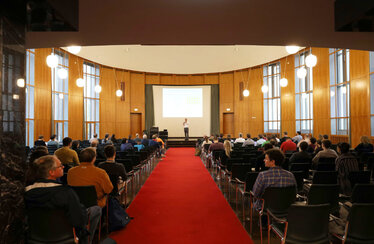On September 25 and 26, 2024, the 10th bwHPC Symposium took place at the University of Freiburg. This year's anniversary event attracted over 80 participants, who presented current developments in the field of high-performance computing (HPC). Over the course of two days, the bwHPC Symposium provided a platform for the exchange of knowledge and ideas in order to strengthen the role of HPC in research. Numerous scientists from all over Baden-Württemberg contributed their work. KIT was also represented by 23 researchers and contributed in the form of a tutorial, a poster presentation and two talks.
Contributions from KIT
On the first day of the symposium, Dr. Robert Barthel, with the help of Martje Armbrecht and Peter Weisbrod, led a tutorial on Introduction to HPC, which offered participants a comprehensive introduction to the use of the bwHPC infrastructure. The tutorial began with an introduction to the infrastructure and the objectives of the bwHPC-S5 project and provided information on how to access the resources. In addition, bwHPC services such as proactive user support were discussed. The first steps for using the bwForCluster and file transfer under Linux and Windows were then explained and an overview of the various data storage services was given. This was followed by an explanation of how to set up and run jobs on a cluster. Another important aspect was the use of different file systems on the clusters. This practice-oriented tutorial enabled participants to get straight into working with HPC clusters and gain valuable experience for their research.
KIT was also represented at the poster session. Ludmilla Obholz and Uwe Falke, with the help of co-authors Andreas Petzold and Serge Sushkov Evdoshenko, presented a poster on the Large Scale Data Facility at KIT (LSDF2), which is the central online data storage system available to all scientists and plays a key role in the storage and processing of large scientific data sets.
Sebastian Brommer's presentation on High Performance Computing Infrastructure for Particle Physics: The Experience of the Karlsruhe Groups was particularly exciting. Brommer explained the essential role of flexible and scalable computing resources for particle physics. At the Institute for Experimental Particle Physics (ETP) in Karlsruhe, the Overlay Batch System (OBS) is used as a uniform access point, which dynamically integrates additional computing resources from external locations using the meta-scheduling tool COBalD/TARDIS. The bwForCluster NEMO is a central resource that is used for simulations and data analyses in the context of large collaborations such as ATLAS, CMS and Belle II.
Another important contribution was made by Matthias Schnepf, who emphasized the role of the NEMO cluster in research into particle physics and dark matter in his presentation Belle II on NEMO: Flavour and Dark Matter Physics. He emphasized how HPC systems efficiently support the analysis of the enormous amounts of data generated in these physics experiments, sometimes through simulations.
About bwHPC
The bwHPC program is an initiative of the state of Baden-Württemberg that offers researchers access to high-performance computing resources for data-intensive research projects. The annual bwHPC symposium promotes exchange and interdisciplinary cooperation in the field of high-performance computing.
The symposium takes place every year, and we are already looking forward to participation and attendance at the bwHPC Symposium 2025!
Further information on the symposium can be found on the bwHPC website.


